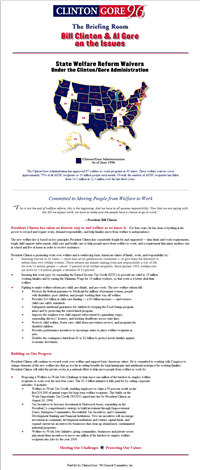|
 Bill Clinton 1996 On The Issues Bill Clinton 1996 On The Issues
Committed to Moving
People from Welfare to Work
"This is not the end of welfare reform, this is the beginning. And we
have to all assume responsibility. Now that we are saying with this bill
we expect work, we have to make sure the people have a chance to go to
work.”
—President Bill Clinton
President Clinton has taken an
historic step to end welfare as we know it. For four years,
he has done everything in his power to reward and require work, demand
responsibility, and help families move from welfare to independence.
The new welfare law is based on key principles President Clinton has
consistently fought for and supported — time limits and work
requirements; tough child support enforcement; child care and health
care to help people move from welfare to work; and a requirement that
minor mothers stay in school and live at home in order to receive
assistance.
President Clinton is promoting work over welfare and is reinforcing
basic American values of family, work, and responsibility by:
 |
Granting waivers to 43 states — more than all his
predecessors combined — to give them the flexibility to reform
their own welfare systems. These reforms are already making work
and responsibility a way of life for over 10 million people —
about 75 percent of all welfare recipients. Since January 1993,
welfare rolls are down by 1.8 million people, a decrease of 13
percent.
|
|
 |
Ensuring that work pays: by expanding the Earned
Income Tax Credit (EITC) to provide tax relief to 15 million
working families and by raising the Minimum Wage for 10 million
workers, so that work is a better deal than welfare.
|
|
 |
Fighting to make welfare reform pro-child,
pro-family, and pro-work. The new welfare reform bill:
 |
Protects the federal guarantee to Medicaid
for millions of pregnant women, people with disabilities,
poor children, and people working their way off welfare.
|
 |
Provides $14 billion in child-care funding —
a $4 billion increase — and restores child-care safety
standards.
|
 |
Safeguards nutritional guarantees for
children by keeping the Food Stamp program intact and by
protecting the school lunch program.
|
 |
Imposes the toughest ever child support
enforcement by garnishing wages, suspending drivers’
licenses, and tracking deadbeats across state lines.
|
 |
Protects child welfare, foster care, child
abuse prevention services, and programs for disabled
children.
|
 |
Provides performance incentives to encourage
states to place welfare recipients in jobs.
|
 |
Doubles the contingency fund from $1 to $2
billion to protect needy families against economic
downturns.
|
|
Building on Our Progress
President Clinton will continue to reward work over welfare and
support basic American values. He is committed to working with Congress
to change elements of the new welfare law that go too far in cutting
benefits for legal immigrants and nutritional assistance for working
families. President Clinton will enlist the private sector in a national
effort to help move people from welfare to work by:
 |
Proposing a Welfare-to-Work Jobs Challenge to help
move one million of the hardest-to-employ welfare recipients to
work over the next four years. This $3.4 billion initiative is
fully paid for by cutting corporate subsidies. It includes:
 |
Welfare-to-Work Tax Credit, enabling
employers to claim a 50 percent credit on the first $10,000
of annual wages for long-term welfare recipients. This
builds on the Work Opportunity Tax Credit (WOTC) signed into
law by President Clinton on August 20, 1996.
|
 |
Tax Incentives to Increase Investment in
Distressed Areas, expanding on the President’s comprehensive
strategy to build investment through Empowerment Zones,
Enterprise Communities, Brownfields Tax Incentives, and
Community Development Banking and Financial Institutions.
New tax incentives will encourage investment in community
development institutions and venture capital funds, and
expand current tax incentives for businesses that clean up
abandoned, contaminated industrial properties.
|
 |
Welfare-to-Work Jobs Initiative, giving
communities, businesses and private sector placement firms
incentives to move one million of the hardest-to-employ
welfare recipients into jobs by the year 2000.
|
|
Source: Bill Clinton for President 1996 Web Site |
|
|
|
|
|
|